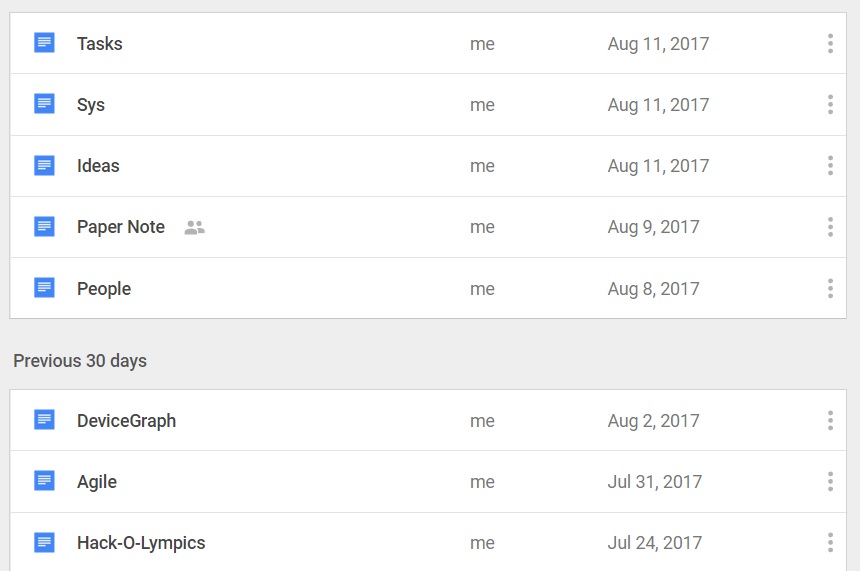In my very first meeting with my mentor at Tapad, after an introduction to DeviceGraph and AdTech 101, we started to discuss the project I would be working on during my internship. The first week was very intense and my mentor understood my struggle in the face of information overload. He showed me his system of organizing information by writing down his incremental knowledge about certain technology as well as his spark of ideas. I adapted his system and developed my own archive to track my learning process and ideas using Google Docs (the picture above). Now, 5 weeks have passed and I have continuously updated the documents as I learn: the more I know, the more I realize I do not know, and the more I want to learn. Learning is an iterative process.
Step 1: build a solid foundation, or as an analogy – a minimum viable product (MVP) of knowledge. No matter how complicated and intricate a certain field is, it always starts from the basic. For example, I was taking the Artificial Intelligence nanodegree from Udacity. The term “AI” may sound quite intimidating for people outside the research field. However, one of the big advantages of MOOCs is that they start from 101, and help build the vocabulary and framework of knowledge for people without much prior experience. The nanodegree equipped me with an overview of the AI field, as well as resources for further study. I am still not an expert in AI research and application, but I am confident that I can now understand latest AI publication conceptually, and know how to search and find answers to my questions. Basics are crucial, because they are the primary interface between experts and everyone else. And if we cannot explain our work in the most plain language to non-experts, most of the time, it is not because our work is so sophisticated, rather, it is because we do not explain it properly.
Step 2: specialize based on our interest or work demand. If our MVP of knowledge is pleasant, we may consider going deeper in certain directions. Just like product development, we may want to differentiate us from generics by developing a particular feature. For me, it is natural language processing (NLP) in the AI field. NLP processes text information generated by human, interprets and analyzes the text and words, and provides insights. For example, sentiment analysis can predict emotions based on a movie review or a twitter; document clustering can catalog relevant webpages into news feed; machine translation can accurately translate language given context. Language accounts for most of our daily communication, and I believe NLP is the key to understanding our identify, consciousnesses and intelligence.
Step 3: practice, ruminate, and go back to step 1 and 2. It is almost impractical to learn everything in one shot because of the following 3 reasons. First, we forget, so even if we learn everything at once, we still cannot remember everything. Second, the more we learn, the better we become at building connections. For example, the first time I read the book “Big Data: A Revolution That Will Transform How We Live, Work, and Think”, I had no working experience in big data and thus the content in the book was to me a distant description of something vague. But over time, as I learned more about the technical details of big data and worked on it myself, my understanding of the influence of big data deepened. One big difference between humans and (non-smart) machines is that we can detect patterns from seemingly unrelated matters and gain new insights. We can build such new connections by practicing and ruminating from our own experience. We can also go back to step 1 and 2, and revisit the foundation. From the neuroscience perspective, each memory retrieval reconstructs a new memory, which is modified by our personal preference and bias. So revisiting the same topic may bring us unexpected inspiration and new connections. Third, there are always blind spots in our learning process, and we may ignore one thing or two. Iterative learning may help reduce such unconscious negligence.
Iteration is not just clueless repeat. Mathematicians understand the power of iteration in logistic regression, and ancient wisdom tells us (iterative) practice makes perfect.
How good is good enough? When could we pause iteration? In computer science and math, we can simply set a threshold or maximum number of iteration. In real world, how do we know our knowledge is good enough? “How do we know our product is good enough for delivery? How do we decide when to launch a product?” I asked the SVP of Media Business these questions at a lunch chat, and she replied, “Product development is an iterative and incremental process. We need to understand what the clients need and deliver products that are beyond their expectations. At the same time, we continue improving and continue meeting clients’ need.” I believe the same principle applies to learning in general. Depending on what our client/goal is (it could be self improvement, launching a dream job, or passing an exam), we need to understand what our competitive advantage is, and at the same time keep learning!
